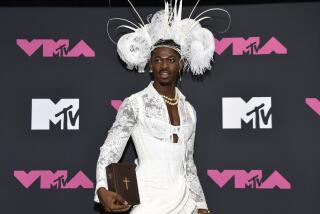‘Life is Good’ for hip-hop’s Nas
In typical hip-hop fashion, Nas arrived late. The rapper swaggered into West Hollywood’s House of Cigars, leaving his entourage outside, eased onto the wicker couch and lighted up a Cuban. But his reason for the delay (not that he needed to explain) was hardly in step with the image of a rap mogul: “I was at the circus with my son,” he said, blowing a curl of smoke into the air.
Twenty years into his prolific career, the man born Nasir Bin Olu Dara Jones has changed the game again. On “Life is Good,” his 10th album, the rapper known for his sharp wit and biting, tough social commentary taps into some of his most honest and compelling subject matter yet: himself.
On “Daughters,” he raps about his teenager — and his past indiscretions — in such candid terms it feels like a landmark moment for him and the genre. “One day she’s your little princess, next day she’s talking boy business,” he raps. “They say the coolest playas and the foulest heartbreakers in the world, God gets us back, he makes us have little girls.”
Despite the unmatchable rhyming skills the revered lyricist has shown on previous efforts — albums filled with carefully crafted, provocative political thoughts and street wisdom — the rapper felt it was time to turn the lens inward.
“People can see through artists who are just stringing them along with antics,” Nas said, clouds of thick smoke hovering over his head. “I can tell when someone I like is not doing the right thing, and I didn’t have any reason to not do the right thing. I wasn’t trying to be like anything other than myself. I feel like people appreciated that I kept it true.”
He used the album’s artwork to set the tone for the disc, his first in four years. On the cover, a pensive Nas sits with a dress belonging to his ex-wife, R&B-dance; singer Kelis, draped across his lap. He’s wearing a cream-colored suit, much like the one he walked down the aisle in. The album cover’s image is a stark contrast to previous covers, which depicted Nas as a prophet, astrologer, disciple and a whip-scarred slave.
“Life is Good” was inspired by Marvin Gaye’s “Here My Dear,” which detailed the groundbreaking singer’s failed marriage and was released as part of a financial settlement. Nas’ marriage is explored on his own album’s beautifully raw final number, “Bye Baby.”
He raps: “Bye baby, I guess you knew why I walked away, When we walked to the altar that was an awesome day. Did counseling, couldn’t force me to stay. Something happens when you say I do, we go astray.”
The son of jazz musician Olu Dara, Nas came up in New York’s drug-fueled, poverty-stricken Queensbridge projects, dropped out of school in the eighth grade, and went on to hustle drugs. A guest verse (his first recording) on Main Source’s “Live at the Barbecue” won him attention, and at 20 he issued his critically lauded, game-changing debut, “Illmatic.”
“Illmatic” is seen as one of the greatest rap albums of all time, and Nas has gone on to enjoy one of the longest, most successful careers in rap (he’s sold over 13 million records). He’ll headline the annual traveling hip-hop festival Rock the Bells on Sunday at San Bernardino’s NOS Events Center.
His staying power is remarkable, given hip-hop’s historic ageism, the East Coast-West Coast rivalry that took the lives of peers, and the rapper’s notable feud with rap royalty Jay-Z. The two made peace and went on to collaborate, and Nas signed to Def Jam during his former rival’s tenure as president.
“Nas’ longevity comes from him having strong lyrical value in his songs, him being more like a poet and improving over time,” said No I.D., the Def Jam vice president, who also produced some “Life Is Good” tracks. “His depth is unlimited.”
Nas is passionate when he discusses the art of rap, and his love of the genre — which he famously said was dead on his 2006 Def Jam debut.
“I’m in the rap game,” he said. “But for me, being a rapper isn’t enough. I see myself as a musician who raps — if that makes sense. I’ve always put the music first. It’s important that I make something that touches people, that moves people. That’s the most important thing, not the individual.”
The album’s deft production, No I.D. and Saleem Remi do most of the heavy lifting, evokes hip-hop’s ‘90s heyday, and provides a reprieve from the generic club raps and futuristic beats filling urban radio.
The record debuted at No. 1 after its release a month ago and is largely considered a true return to form. Nas’ 2008 album “Untitled,” though successful, was marred by controversy surrounding the album’s original (and unprintable) title. It sparked a heated debate over censorship and saw conservative talk show host Bill O’Reilly labeling him as “vile.”
It didn’t hurt Nas, much. “My ego is not as big as hip-hop is,” he said.
A number of troubles came between his last album and now: The aforementioned divorce and its (expensive) settlement; owing Uncle Sam more than $6 million in back taxes; and a bizarre story circulating in which a no-show by Nas at a concert resulted in the kidnapping of an African promoter.
“I didn’t know that maybe [the album] is what he needed therapeutically, as a human being, to process naturally, without him having to conjure up a scheme for marketing,” No I.D. said. “It was really just him.”
Nas beams when he talks about accomplishing the album’s mission — making music that was “true to me,” he calls it. And he did the latter with an optimistic bent. On the album’s dance hall-infused single, “The Don,” he declares: “Screw sadness.”
“I just don’t believe in beating yourself down, when God gives us all a chance,” he said. “No matter what your life is like, the fact that you have life is a blessing. We make mountains out of our problems. So I just gave you mine, and let you see me through it. You can watch what I’ve gone through in this album and I could still come out smiling.”
More to Read
The biggest entertainment stories
Get our big stories about Hollywood, film, television, music, arts, culture and more right in your inbox as soon as they publish.
You may occasionally receive promotional content from the Los Angeles Times.







